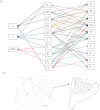Modelling the effects of sanitary policies on European vulture conservation
- PMID: 23082243
- PMCID: PMC3475340
- DOI: 10.1038/srep00753
Modelling the effects of sanitary policies on European vulture conservation
Abstract
Biodiversity losses are increasing as a consequence of negative anthropogenic effects on ecosystem dynamics. However, the magnitude and complexity of these effects may still be greatly underestimated. Most Old World vultures have experienced rapid population declines in recent years. In Europe, their immediate conservation depends on changes in health regulations affecting the availability of food provided by domestic carcasses. Information is lacking on the effects of a hypothetical food shortage on the population dynamics of vultures, and is necessary to assess the potential impacts of policy decisions on future changes in biodiversity and ecosystem services. A novel computational model (P-systems) was used to model these effects, forecasting a rapid decline in the Eurasian griffon vulture (Gyps fulvus). By contrast, vulture species with greater plasticity in their dietary range appeared less sensitive to declining food availability. This study extends our understanding of vulture ecosystem services, which have social and economic implications.
Figures





References
-
- Loreau M., Naeem S. & Inchausti P. Biodiversity and ecosystem functioning: synthesis and perspectives, Oxford University Press, 2002.
-
- Naeem S. et al. Biodiversity, ecosystem functioning and human wellbeing: an ecological and economic perspective, Oxford University Press, 2009.
-
- Whelan C. J., Wenny D. G. & Marquis R. J. Ecosystem services provided by birds. Ann. New York Acad. Sci. 1134, 25–60 (2008). - PubMed
Publication types
MeSH terms
LinkOut - more resources
Full Text Sources

